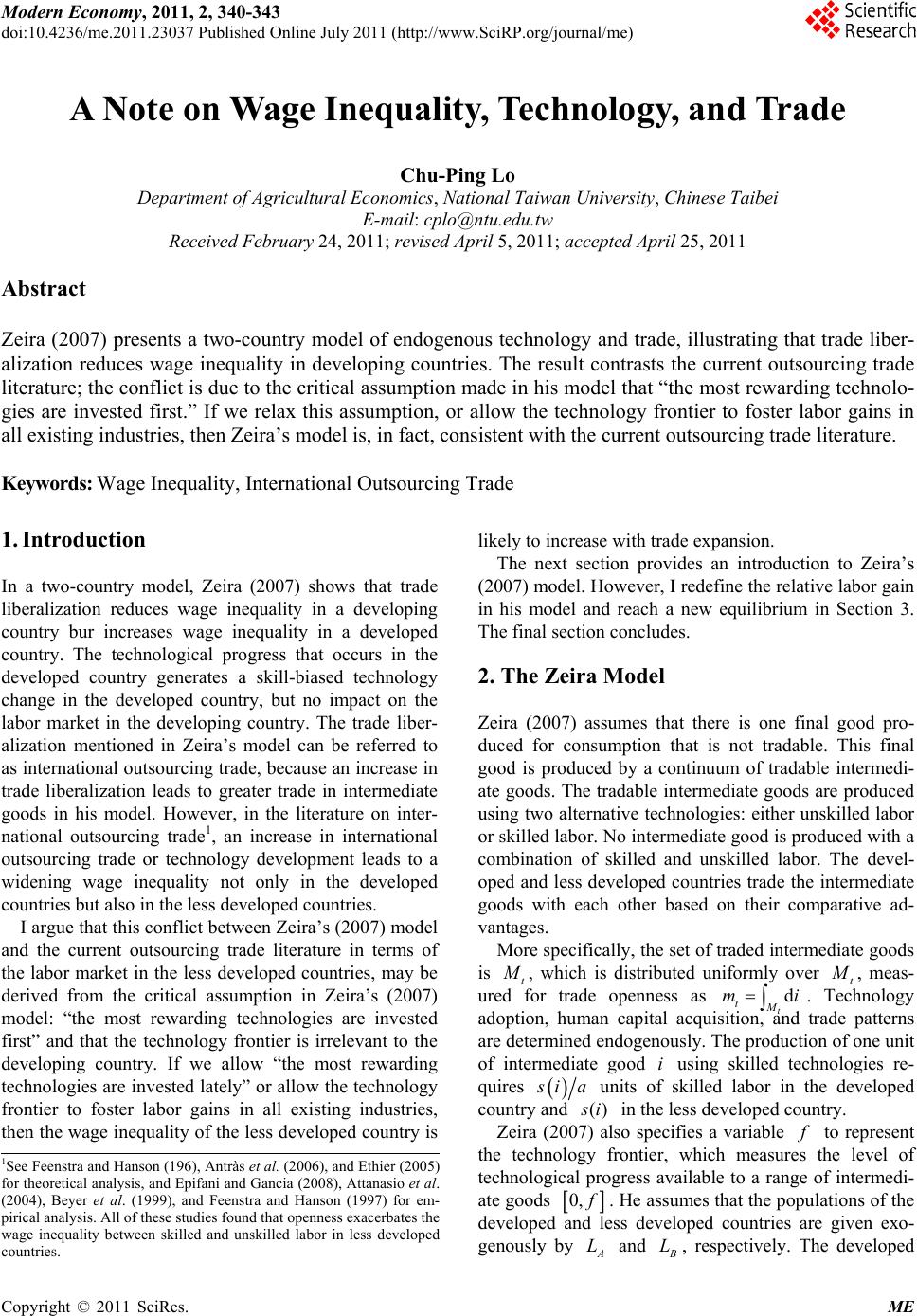
Modern Economy, 2011, 2, 340-343
doi:10.4236/me.2011.23037 Published Online July 2011 (http://www.SciRP.org/journal/me)
Copyright © 2011 SciRes. ME
A Note on Wage Inequality, Technology, and Trade
Chu-Ping Lo
Department of Agricultural Economics, National Ta iwan University, Chinese Taibei
E-mail: cplo@ntu.edu.tw
Received February 24, 2011; revised April 5, 2011; accepted April 25, 2011
Abstract
Zeira (2007) presents a two-country model of endogenous technology and trade, illustrating that trade liber-
alization reduces wage inequality in developing countries. The result contrasts the current outsourcing trade
literature; the conflict is due to the critical assumption made in his model that “the most rewarding technolo-
gies are invested first.” If we relax this assumption, or allow the technology frontier to foster labor gains in
all existing industries, then Zeira’s model is, in fact, consistent with the current outsourcing trade literature.
Keywords: Wage Inequality, International Outsourcing Trade
1. Introduction
In a two-country model, Zeira (2007) shows that trade
liberalization reduces wage inequality in a developing
country bur increases wage inequality in a developed
country. The technological progress that occurs in the
developed country generates a skill-biased technology
change in the developed country, but no impact on the
labor market in the developing country. The trade liber-
alization mentioned in Zeira’s model can be referred to
as international outsourcing trade, because an increase in
trade liberalization leads to greater trade in intermediate
goods in his model. However, in the literature on inter-
national outsourcing trade1, an increase in international
outsourcing trade or technology development leads to a
widening wage inequality not only in the developed
countries but also in the less deve loped countries.
I argue that this conflict between Zeira’s (2007) model
and the current outsourcing trade literature in terms of
the labor market in the less developed countries, may be
derived from the critical assumption in Zeira’s (2007)
model: “the most rewarding technologies are invested
first” and that the technology frontier is irrelevant to the
developing country. If we allow “the most rewarding
technologies are inv ested lately” or allow the technolog y
frontier to foster labor gains in all existing industries,
then the wage inequality o f the less developed country is
likely to increase with trade ex pansion.
The next section provides an introduction to Zeira’s
(2007) model. However, I redefin e the relative labor gain
in his model and reach a new equilibrium in Section 3.
The final section concludes.
2. The Zeira Model
Zeira (2007) assumes that there is one final good pro-
duced for consumption that is not tradable. This final
good is produced by a continuum of tradable intermedi-
ate goods. The tradable intermediate goods are produ ced
using two alternative technologies: either unskilled labor
or skilled labor. No intermediate good is prod uced with a
combination of skilled and unskilled labor. The devel-
oped and less developed countries trade the intermediate
goods with each other based on their comparative ad-
vantages.
More specifically, the set of traded intermediate goods
is t
, which is distributed uniformly over t
, meas-
ured for trade openness as t
tM. Technology
adoption, human capital acquisition, and trade patterns
are determined endogenously. The production of one unit
of intermediate good using skilled technologies re-
quires
dmi
i
ia units of skilled labor in the developed
country and ()
i in the less developed country.
Zeira (2007) also specifies a variable
to represent
the technology frontier, which measures the level of
technological progress available to a range of intermedi-
ate goods
0,
. He assumes that the populations of the
developed and less developed countries are given exo-
genously by and
A
L
L, respectively. The developed
1See Feenstra and Hanson (196), Antràs et al. (2006), and Ethier (2005)
for theoretical analysis, and Epifani and Gancia (2008), Attanasio et al.
(2004), Beyer et al. (1999), and Feenstra and Hanson (1997) for em-
irical analysis. All of these studies found that openness exacerbates the
wage inequality between skilled and unskilled labor in less developed
countries.